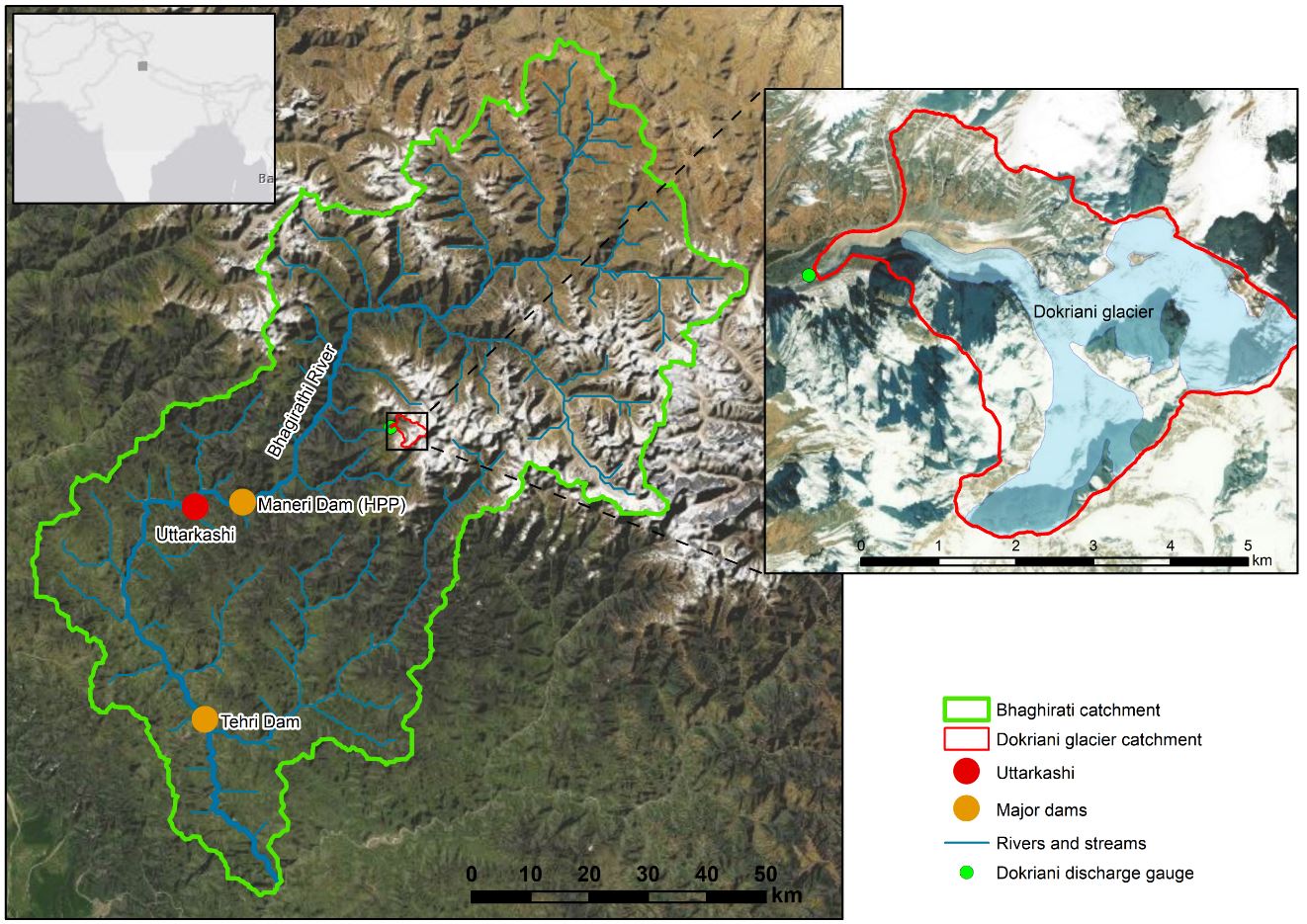The Swiss Agency for Development and Cooperation’s (SDCs) Global Programme Climate Change and Environment (GP CCE) India is supporting the operationalization of climate change adaptation actions in the mountain states of Uttarakhand, Sikkim and Himachal Pradesh through the phase two of the “Strengthening State Strategies for Climate Action” (3SCA) project that was launched in 2020. Within this framework SDC has granted a project to FutureWater, together with Utrecht University, The Energy and Resources Institute, the University of Geneva and a few individual experts. The activities in this project focus on the development and application of climate responsive models and approaches for integrated water resources management (IWRM) for a selected glacier-fed sub-basin system in Uttarakhand and that at the same will find place in relevant policy frameworks paving way for their replication across the Indian Himalayan Region (IHR) and other mountainous regions.
The Swiss Agency for Development and Cooperation’s (SDCs) Global Programme Climate Change and Environment (GP CCE) India is supporting the operationalization of climate change adaptation actions in the mountain states of Uttarakhand, Sikkim and Himachal Pradesh through the phase two of the “Strengthening State Strategies for Climate Action” (3SCA) project that was launched in 2020. The second phase of 3SCA (2020-23), known as the Strengthening Climate Change Adaptation in Himalayas (SCA-Himalayas), while building on the experience and achievements of Phase 1, aims to showcase mountain ecosystem appropriate scalable approaches for climate resilience in water and disaster risk management sectors; using these efforts to enhance the capacities of the institutions across the Indian Himalayan Region (IHR) to plan, implement and mainstream adaptation actions into their programmes and policy frameworks; and disseminating the experiences and lessons at the regional and global level.
Within this programme, SDC has granted a project to FutureWater, together with Utrecht University, The Energy and Resources Institute (TERI), the University of Geneva and a few individual experts. The activities in this project focus on the development and application of climate responsive models and approaches for integrated water resources management (IWRM) for a selected glacier-fed sub-basin system in Uttarakhand and that at the same will find place in relevant policy frameworks paving way for their replication across IHR and other mountainous regions. This will allow the policy makers from the mountain states in India to manage the available water resources in an efficient and effective manner, benefiting the populations depending on these resources.
The combination of future climate change and socio-economic development poses great challenges for water security in areas depending on mountain water (Immerzeel et al., 2019). Climate change affects Asia’s high mountain water supply by its impact on the cryosphere. Changes in glacier ice storage, snow dynamics, evaporation rates lead to changes in runoff composition, overall water availability, seasonal shifts in hydrographs, and increases in extremely high and low flows (Huss and Hock, 2018; Lutz et al., 2014a). On the other and, downstream water demand in South Asia increases rapidly under population growth and increasing welfare boosting the demand for and electricity generation through hydropower. To address and adapt to these challenges integrated water resource management (IWRM) approaches and decision support systems (DSS) tailored to glacier- and snow-fed subbasins are required.
To fulfil the mandate outlined by SDC a framework is presented for IWRM and DSS for Himalayan subbasins consisting of three integrated platforms. (i) A modelling and decision support platform built around a multi-scale modelling framework for glacier and snow fed subbasins, based on state-of-the art and “easy to use” modelling technology. (ii) A stakeholder engagement platform to consult key stakeholders, identify key IWRM issues and co-design a new IWRM plan for Bhagirathi subbasin. (iii) A capacity building platform with on-site training and e-learning modules for the key project components: glacio-hydrological modelling, IWRM and DSS, to ensure the sustainability of the approach and pave the way for upscaling to other subbasins in the Indian Himalayan Region.
The three platforms are designed designed to be flexible, integrated and interactive. Moreover they align with the three outcomes of the project, thus contributing to: develop and validate an integrated climate resilient water resource management approach (Outcome 1); increase technical and institutional capacity in the fields of hydrological modelling, IWRM and DSS (Outcome 2); support the embedding of the IWRM approach tailored to glacier-fed Indian Himalayan subbasins in policies, and provide generic outputs and guidelines to facilitate upscaling to other subbasins in the Indian Himalayan Region (Outcome 3).
The modelling and decision support platform is designed for operation under the data scarce conditions faced in Himalayan catchments, and yields reliable outputs and projections. The modelling toolset covers the Bhagirathi watershed (Figure below) and consists of 3 hydrological models: (i) a high resolution glacio-hydrological model for the Dokriani glacier catchment (SPHY-Dokriani). Key parameters derived with this model are upscaled to (ii) a distributed glacio-hydrological model that covers the Bhagirathi subbasin (SPHYBhagirathi). Outputs of this model feed into (iii) a water allocation model that overlays the SPHY-Bhagirathi model in the downstream parts of the basin, where water demands are located (WEAP–PODIUMSIM Bhagirathi). This modelling toolset is forced with downscaled climate change projections and socio-economic projections to simulate future changes in water supply and demand in the subbasin. On the basis of stakeholder inputs, adaptation options are identified and implemented in the water allocation model for scenario analysis. Thus, socio-economic projections and adaptation options are co-designed with the stakeholders to ensure maximum applicability, and are tailored to the requirements for formulation of the new IWRM plan. The outputs of the modelling toolset feed into the Decision Support System, where they are presented in such a way that they can truly support decision making in this subbasin. Results of the modelling, decision support and stakeholder engagement platforms jointly support the co-design of an IWRM plan for the subbasin. Capacity in glacio-hydrological modelling, IWRM and the use of DSS is built through a combination of on-site training and e-learning; replicable training modules are developed for glacio-hydrological modelling, IWRM and DSS in general and for this particular approach to support implementation and sustainability.

Publicaciones relacionadas
2022 - FutureWater Report 253
Water Allocation in Bhagirathi Basin, India
Droogers, P., Khanal, S., Hunink, J.E.
2022 - FutureWater Report 252
Present-day and Future Changes in the Hydrology of the Bhagirathi Basin
Khanal, S., Nick, F., Fiddes, J., Kraaijenbrink, P., Immerzeel, W., Hunink, J.E.




